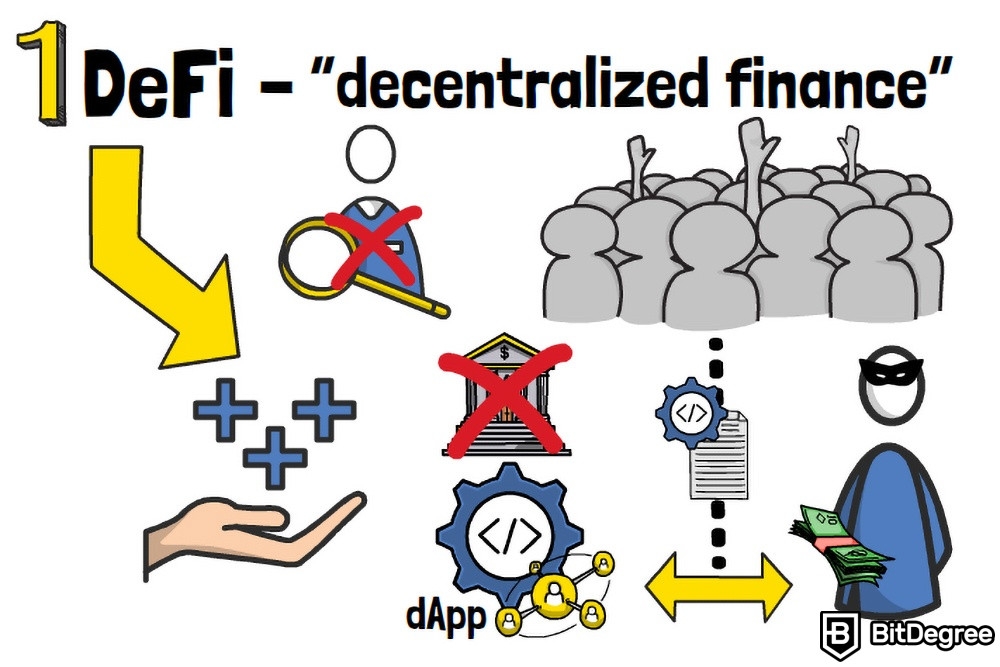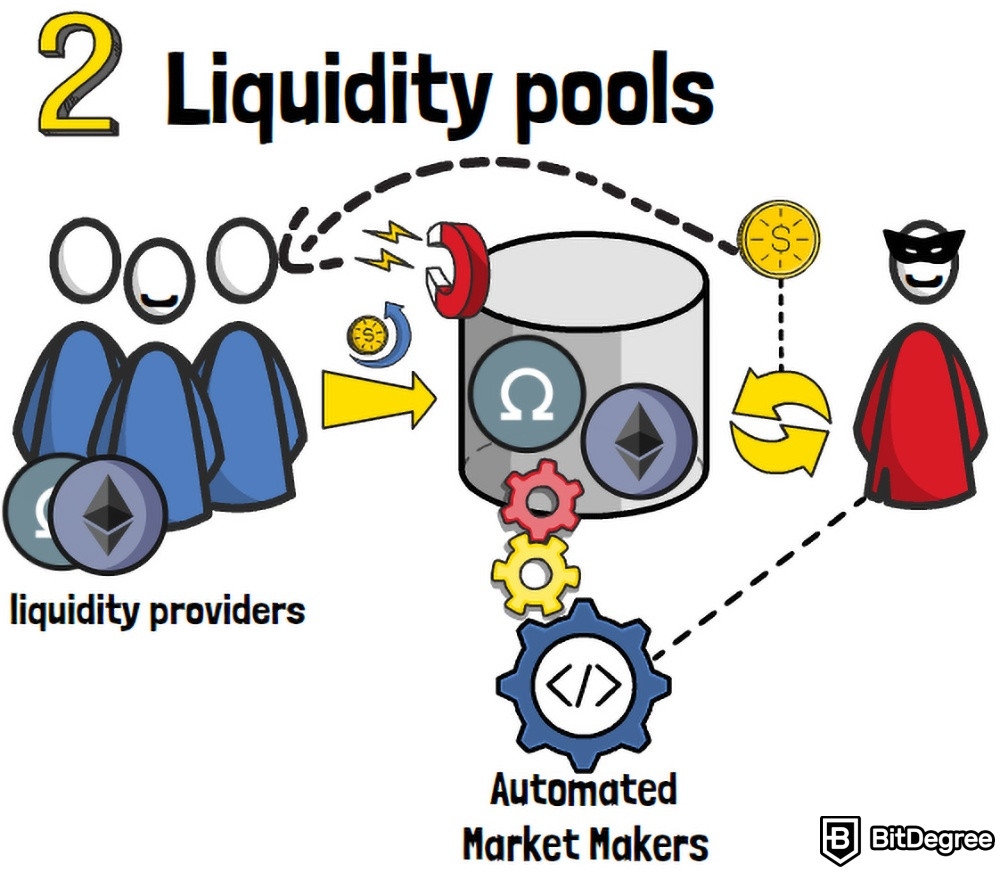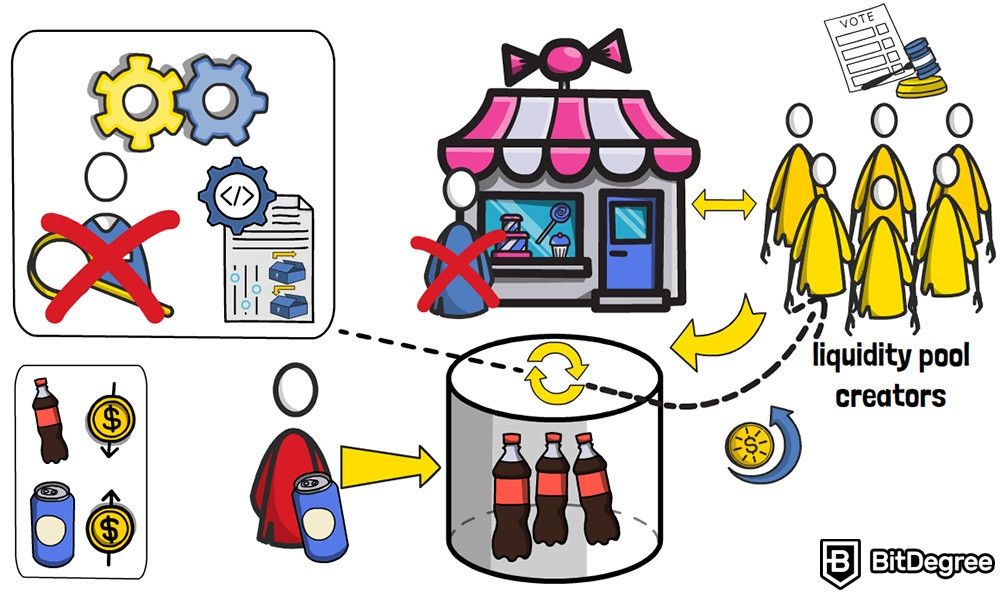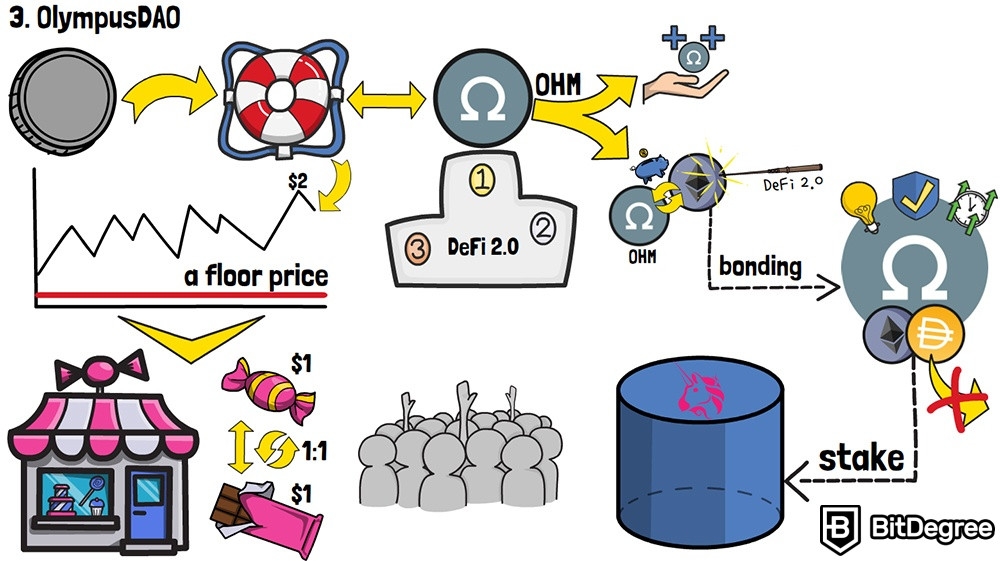6.2 DeFi 2.0: The New Version of Decentralized Finance
Free Airdrop Season 7 is LIVE! Answer fun questions or do simple tasks to earn rewards from the $30K BitDegree prize pool. Participate Now ! 🔥
If you’ve been following the crypto space for some time now, you’ve undoubtedly heard about DeFi - decentralized finance. It was a really hot topic in the summer of 2020 and has retained its relevance, as a new field of finance, to this day.
However, while DeFi might still be a new concept, there’s actually an even newer term being thrown around - DeFi 2.0. And this type of decentralized finance aims to solve the core issues that DeFi 1.0 is facing.
In this section, I’m going to tell you about DeFi 2.0. To be a bit more specific, I’ll tell you what DeFi 2.0 is, how it’s different from DeFi 1.0, and also give an illustrative example of one of the most successful DeFi 2.0 projects.
Now, let’s get to it!

Video Explainer
Video Explainer: DeFi 2.0: The New Version of Decentralized Finance
Reading is not your thing? Watch the "DeFi 2.0: The New Version of Decentralized Finance" video explainer
What is Defi 2.0? (Explained with Animations)


What is DeFi 2.0?
So, before we jump into DeFi 2.0, there are a couple of terms that you need to be familiar with, first. Since it’s not exactly a very simple topic, if you feel that you need more information at any point in time, make sure to check out the previous sections of this BitDegree Crypto 101 Handbook.
So, the very first term that you need to be familiar with is DeFi. It means “decentralized finance”, and is a form of finance that doesn’t have any central authorities, and is instead governed by the communities behind DeFi crypto projects.

So think about it this way - with DeFi 1.0, instead of getting a loan from a centralized bank, you would go to a dApp (a decentralized application, or simply - a DeFi project) that specializes in loans, and borrow money from there. This money would be supplied to you by the community behind the project, and you would be able to interact with the dApp anonymously. On top of that, everything would be governed by smart contracts, so there’s no room for human error or a single person's decision.
One of the key features of DeFi, and the second big term that you need to be familiar with in this section, are liquidity pools. A liquidity pool is a place that stores all of the cryptocurrency tokens that are available to be traded and are provided by liquidity providers - the DeFi community. It’s like a shelf of candy in a shop - if there are 5 candies on the shelf, that means that you can purchase up to 5 candies until the shop runs out of stock.
That being the case, however, if there’s only one candy on the shelf, it’s probably going to be much more expensive, since while the demand for candies remains the same, the supply is limited to a single candy. This works both ways, mind you - if there are hundreds of candies available to be sold, and the demand doesn’t increase, the candies will cost less!
Up to this point, everything is just basic economics. However, this is where liquidity pools come in.

A liquidity pool allows a project to attract investors - the new liquidity providers, who will then bring in two types of tokens - a project token, as well as some sort of leverage, such as Ethereum or DAI.
Over time, as other people come in and trade these two tokens on the liquidity pool, the investors receive passive interest from the trading fees that these people pay. So, you have happy investors (since they receive passive income), as well as happy traders (since they don’t need to find another person to perform the trade, and can trade anonymously on the liquidity pool).
Now, just to be meticulous about the details, the traders don’t actually trade on the liquidity pools. Instead, the trading processes happen on Automated Market Makers - special platforms designed to facilitate those trading activities utilizing liquidity pools. Not to go into too much depth regarding the subject, I’ll put it this way - you can look at AMMs as those same shops where you buy candy. In this case, liquidity pools would be the shelves where the candy is placed.
To sum up, DeFi is an automated decentralized financial field with no single owner, that has implemented Automated Market Maker algorithms that utilize liquidity pools, which are filled with cryptocurrencies provided by liquidity providers (AKA investors and initial project owners).
It’s like a shop with no single owner but instead owned by people who have brought their own goods into the same shop’s pool, so that the shop would trade them for other goods brought by other clients. By doing so, these liquidity pool creators become co-owners of the whole shop, with voting and business decision rights. Their shop trades the collectively-provided goods with their clients autonomously, without the intervention from owners or any other humans. All those trades are based on pre-programmed trading rules.

Finally, shop co-owners receive their passive interest rate income after each trade happens. Theoretically, the pool will never become empty, since, every time a trade happens, it receives new goods from clients in exchange for old ones. Pre-programmed trading rules of the shop correct the prices and exchange value ratio automatically, based on the supply & demand of goods, and the actual quantities of the goods in its own pool.
So, basically, if the pool is full of Coca-Cola, its price will go down, and the price of Pepsi will start to rise because the pool is currently in scarcity of it.
That's about it on the terminology side of things - at least for the time being. Now, let’s move on to DeFi 2.0.
To put it very simply, DeFi 2.0 is the second generation of dApps that are concerned with decentralized finance. While the differences between DeFi 1.0 and DeFi 2.0 aren’t going to be evident for an outsider looking in, if you know what to look out for, you’ll soon notice that there’s a rather obvious trend. Specifically, DeFi 2.0 projects aim to improve on the weakest and most vulnerable parts of traditional DeFi.
DeFi 2.0 vs DeFi 1.0
One thing that is super-important in all DeFi ventures is the liquidity of the pool. It’s actually the main area where DeFi 2.0 is different from traditional decentralized finance.
With your traditional DeFi projects, teams tend to put a lot of their native token into the liquidity pool, hoping this will attract other investors. With time, it’s often successful - investors come in and bring their own coins and tokens into the pool, and as they start earning passive returns, the pool becomes more and more popular.
However, this is where the core issue reveals itself - if a DeFi project depends on the investors’ funds in the liquidity pool in order to survive, it risks huge token price volatility and general uncertainty.
Think of it this way - if you have no interest in a project, and are only investing in order to mine liquidity (earn a passive income), whenever you spot a better offer (such as one with a higher annual percentage yield), you’re probably going to jump ship, and transfer your investment there! It’s like eating at the same restaurant every day since the food there is OK and the prices are great. If, however, the prices start to rise, or the quality of the food goes down, you will surely consider switching your lunch providers!
This puts a lot of pressure on the liquidity pool, and the project that it’s associated with. In turn, if there’s a big liquidity provider turnaround, this will create a lot of instability and will lead to the price of the project token swinging quite a bit.
The only hope that DeFi 1.0 projects have when it comes to preserving their investors in the long run, is to try and create an amazing and appealing project. This, in turn, would incentivize investors to keep their investment on the platform, even after the initial liquidity mining period is over.
As you can probably imagine, though, creating a unique and groundbreaking project isn’t easy to do. Since retaining long-term investors is such a struggle for traditional, DeFi 1.0 projects, some crypto enthusiasts have come up with very interesting and unique decisions on how to avoid this issue altogether.
These decisions lead us to DeFi 2.0. In order to better understand what I’m talking about, let’s take one of the most popular DeFi 2.0 projects as an example.
OlympusDAO
OlympusDAO is often seen as the biggest representing project of DeFi 2.0. Many crypto enthusiasts view OlympusDAO as the most interesting decentralized finance experiment of our time, due to its innovative approach to solving the liquidity problems of traditional DeFi projects!
In short, OlympusDAO is a decentralized reserve currency protocol. Essentially, Olympus has a token called OHM, and bases all of its operations around it. These operations include staking, bonds, liquidity provision, and so on.

The OHM token is actually what makes Olympus stand out from the crowd. Each OHM token is backed by a selection of cryptocurrency assets - this, in turn, establishes a ground price for the token. In other words, OHM has a certain price threshold (or a floor price) which theoretically shouldn’t be crossed.
In order for you to understand this concept better, think about it this way. Imagine the same candy store I mentioned earlier. Now, let’s say that a candy bar in the store is priced at $1. However, the shop owner has also backed each of these candy bars with other chocolate bars that he has in the warehouse. Meaning that people will always be able to trade a candy bar for a chocolate bar, at a ratio of 1:1.
Now, the candy bar can become more expensive, and cost $2, if there’s a huge demand for it. However, it can theoretically never go below $1, since this is the value of the chocolate bars in the warehouse. So, there’s another asset to back the price of the candy bars!
Getting back to OlympusDAO and DeFi 2.0, users are able to do two things with their OHM tokens. They can stake them, and get more OHM tokens as rewards, or trade their cryptocurrencies for OHM tokens, at a discounted price. By the way, if you're not familiar with what staking is, make sure to read the section dedicated to this topic - it will all become much clearer!

Now, the second process that I’ve mentioned is where the DeFi 2.0 magic happens. Whenever someone trades OHM tokens, at a discounted price, the cryptocurrencies that they trade for the OHM tokens go to OlympusDAO. This process is called bonding.
OlympusDAO then uses these newly acquired assets - such as Ethereum, or the DAI stablecoin - as liquidity for their operations. So, essentially, Olympus becomes the liquidity holder and can stake the assets on other popular liquidity pools, such as that of Uniswap.
Remember when I told you that liquidity providers leaving a project is the main problem of traditional DeFi 1.0 platforms? Well, in the case of Olympus, since it becomes the liquidity holder, it’s not going to “leave itself”, since all of the liquidity is in the project’s metaphorical hands. This, in theory, creates a somewhat safe and established liquidity flow and ensures that the project is funded, long-term.
Finishing Off
Now, I do have to admit - this can all be pretty difficult to wrap your head around.
DeFi 2.0 is a complex subject, but to recap, I can tell you this - the main message that you should have gotten out of this section is that traditional DeFi (AKA DeFi 1.0) suffers from liquidity providers leaving projects for other, more-promising opportunities at almost any time, and DeFi 2.0 projects aim to solve this by implementing special, complex mechanisms that allow them to become the holders of their own liquidity. In many cases, this solution results in the projects not relying on assets staked by other, third-party investors.
Naturally, the topic is even more complex - OlympusDAO itself has launched OlympusPRO, which offers other projects the opportunity to use the same bonding mechanism in their own tokenomics. Then you have dedicated marketplaces, advanced staking pool functionality, and many more intricacies, but all of these probably should be discussed in another section more thoroughly.










